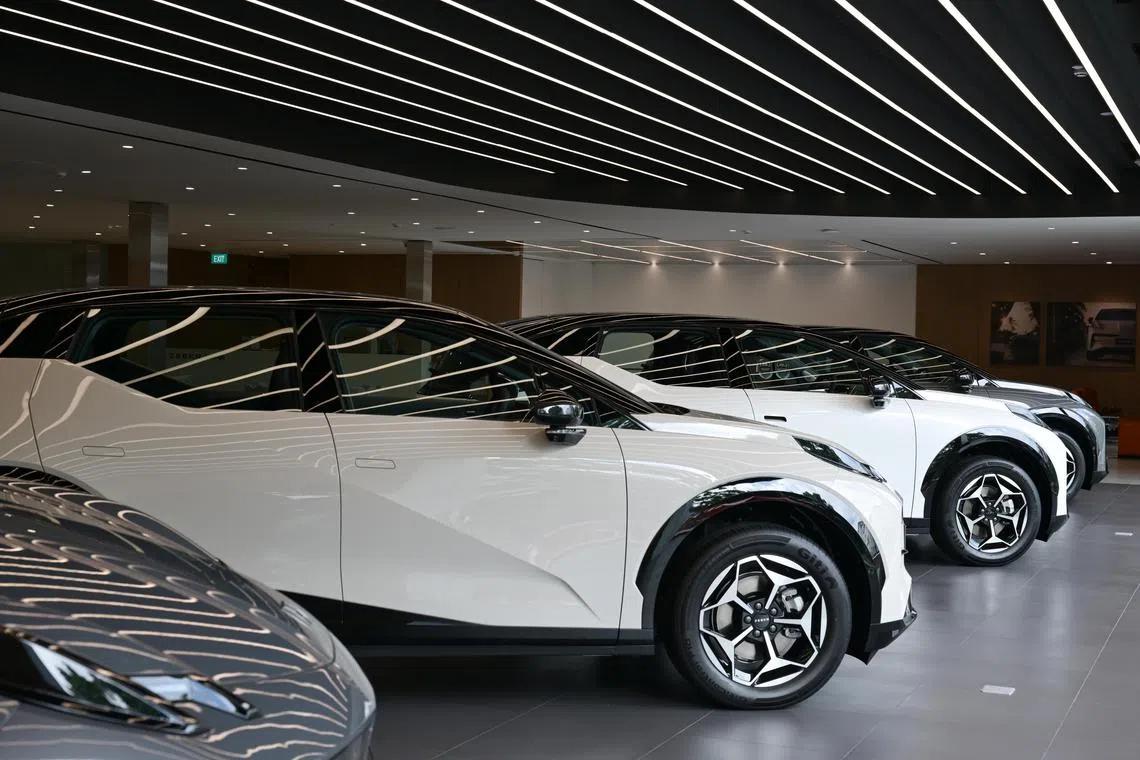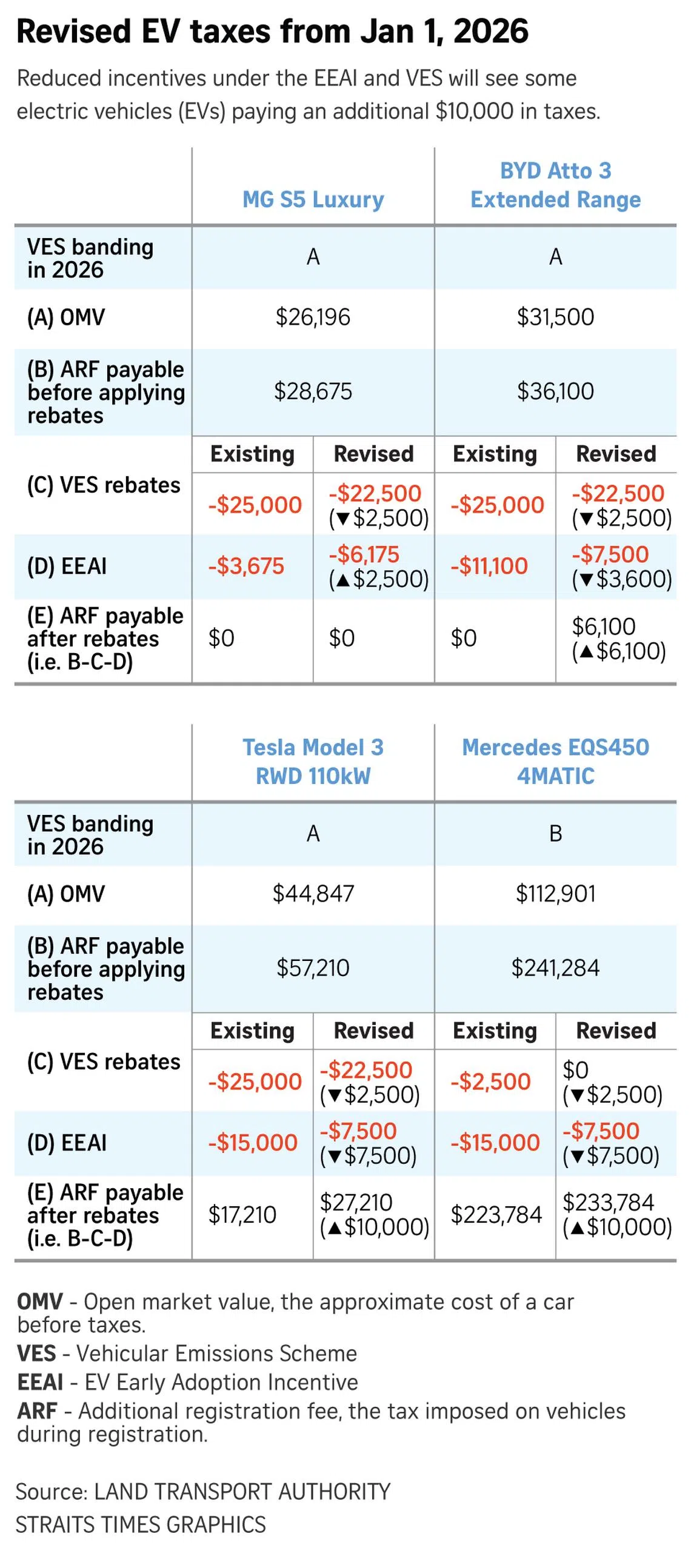News analysis
Why Singapore has opted for fewer carrots, more sticks to get car buyers to go green
Sign up now: Get ST's newsletters delivered to your inbox

Incentives for EVs are being reduced, while surcharges for non-electric cars are significantly raised.
ST PHOTO: NG SOR LUAN
Follow topic:
SINGAPORE – When it comes to going green, electric vehicles (EVs) are Singapore’s preferred choice. Come 2026, such cars will continue to receive rebates, while non-electric cars either get nothing or face higher surcharges.
This follows revisions to the EV Early Adoption Incentive (EEAI) and the Vehicular Emissions Scheme (VES) that apply from Jan 1.
Announced on Sept 8, the moves align with Singapore’s broader objective of having “100 per cent cleaner energy vehicles by 2040”.
Cleaner energy vehicles refer to electric cars and hybrids. To get to that goal, it will no longer be possible to register new cars that rely solely on engines in Singapore from 2030.
In the new year, the EEAI will be halved to $7,500 and the incentive will be removed by the end of 2026.
The new VES rebate cap for EVs will also be reduced from $25,000 now to $22,500 in 2026.
This continues the reduction of combined rebates for EVs from both schemes since 2021, and the $10,000 cut from 2026 will be the most significant yet.
The cuts do not mean that Singapore’s commitment to electrification is wavering, but rather have more to do with the growing popularity of EVs.
The early adoption incentive is a temporary measure to defray the higher upfront cost of electric cars, bringing the selling price closer to that of conventional cars.
With the rebates, electric cars at the mass-market level can be priced significantly lower than comparable non-electric cars.
For example, the BYD Atto 2 – a compact electric sport utility vehicle – is priced more than $12,000 lower than the non-electric Honda HR-V.
This is a gap large enough for experts, like Associate Professor Walter Theseira from the Singapore University of Social Sciences, to believe that the incentive amount can be reduced even further.
Given the considerable price advantage that EVs have over non-electric options, it is little wonder that electric models are flying off car showrooms.
EVs accounted for 41.6 per cent of new cars in the first seven months of 2025, up from 33.6 per cent in 2024 and 18.3 per cent in 2023.
Industry experts do not expect demand for EVs to cool in 2026 with the reduced rebates. One reason is that not all EVs qualify for the maximum rebate amount under the current regime as the amount of tax these cars are liable for is relatively low.
For example, the MG S5 receives only $28,675 in combined rebates in 2025. When the maximum rebate for EVs in 2026 is reduced from $40,000 to $30,000, the MG S5 will not be any worse off.
Electric cars will very likely continue to have a pricing advantage in 2026, after heftier surcharges for non-EVs kick in.
EV sellers are bullish that the adoption rate will continue to rise. Besides price, they point to consumers’ increased acceptance of the technology and more models with better features in the pipeline.
Competition will also further intensify with new EV brands such as Leapmotor and Nio coming to Singapore.
Across the board, expect EV dealers to be very active in the market to win customers over.
Still, there will be consumers who will reject electric cars as they believe that such vehicles do not suit their needs.
Other than reservations about whether there are enough EV chargers around – as at June, the current ratio stands at one EV charger to slightly over three EVs – some drivers may want to wait a while longer for EV technology to mature further, with longer operating ranges and faster charging speeds, as well as for more types of EVs to be available.
The variety of electric cars is still relatively limited. Even with the influx of new brands, the majority of the offerings tends to be sport utility vehicles.
There are no direct substitutes to four-door family cars like a mid-sized Honda Civic or a Hyundai Avante, for instance. Neither are there many seven-seater electric cars to choose from, apart from the handful that tend to be quite large.
For car buyers who remain in the non-EV camp, the next greenest option would be hybrids. These are cars with electric motors that can be driven for some distances without the engine running. The battery gets charged when the engine is running. There are also plug-in hybrids that can use EV chargers to power up their batteries.
Such hybrids are better for the environment because they function just like EVs when using only their electric motors to get around, making no exhaust emissions.
Drivers also like hybrids because they are usually very fuel-efficient, so a tank of petrol can go much further than a non-hybrid. In addition, such cars also do not have to rely on charger availability.
In the updated VES for 2026, hybrids will no longer qualify for the $2,500 rebate. The withdrawal does not come as a big surprise, given that the rebate for hybrids was previously cut from $15,000 in 2021 to $5,000 in 2024, then halved in 2025.
While the actual impact of the $2,500 rebate is insignificant at a time when a typical mass-market car costs more than $180,000, the continuous reduction of support for hybrids can be viewed as the technology not being favoured in Singapore’s vision for cleaner energy cars by 2040.
However token the incentive for hybrids may be, providing it would have signalled that hybrid cars have a role to play in Singapore’s longer-term objective. The support would also reflect the role of hybrid cars as a transitional technology towards full electrification.
Not providing rebates for hybrids makes clear the Government’s preference for EVs in greening Singapore’s vehicle fleet.

Another outcome of the VES changes is that cars with higher emissions are significantly worse off.
The surcharge amounts will be raised by between $7,500 and $10,000 in the new year, and the increases will surely have an impact on the minds of consumers when deciding on the type of car to buy.
Going forward, there may be room to fine-tune the VES for Singapore to have a cleaner vehicle fleet.
The VES is outcome-based, as opposed to a previous scheme called the Green Vehicle Rebate, which was based on specific engine types.
VES banding looks at a car’s carbon dioxide levels and four other tailpipe pollutants: carbon monoxide, hydrocarbons, nitrogen oxides and particulate matter. The amount of rebate or surcharge is determined by the worst performing of the five emissions.
When the VES was revised for the 2024 to 2025 period, the pollutant thresholds for the five types of emissions measured were tightened. For example, to qualify for the VES band that gives a $5,000 rebate, the threshold for the amount of hydrocarbons was between 0 and less than 0.024g/km, down from between 0.02 to 0.036g/km.
One possibility will be to tighten the thresholds even further to push the conventional cars, which do not have hybrid technology, into a higher penalty banding than they do now. This will help to speed up Singapore’s transition towards a full cleaner energy vehicle fleet.
Another area to consider is how EVs fare under VES. Without any actual tailpipe emission to speak of, the rating for VES for electric cars is derived from their energy consumption, which is converted to the amount of carbon dioxide.
This is because not all EVs are equally green, with some less energy-efficient than others.
As electric cars grow in popularity and technology improves, the time may be ripe to relook the formula that qualifies EVs under the VES such that buyers are incentivised to opt for not just EVs, but also the most energy-efficient ones.
In other words, a more energy-efficient EV should enjoy a more beneficial VES banding and hence, more incentives than a less energy-efficient one.
This in turn means more carrots to nudge consumers to pick greener options, which is in keeping with the idea behind the VES all this while.


